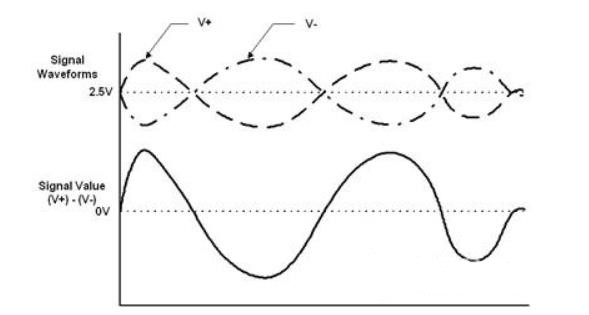A differential signal uses a numerical value to represent the difference between two physical quantities. Strictly speaking, all voltage signals are differential, because one voltage can only be relative to another voltage. In some systems, the system'ground' is used as the voltage reference point. When'ground' is used as a voltage measurement reference, this signal planning is called single-ended. We use this term because the signal is represented by the voltage on a single conductor.
On the other hand, a differential signal acts on two conductors. The signal value is the voltage difference between the two conductors. Although not very necessary, the average value of these two voltages will always remain the same. Let's use a method to make a metaphor for differential signals. Differential signals are like two people on a seesaw. When one person is lifted up, the other is lifted off-but their average position remains the same. Continuing the analogy of the seesaw, a positive value can indicate that the person on the left is taller than the person on the right, while a negative value indicates that the person on the right is taller than the person on the left. 0 means that both people are at the same level.

Figure 1 Differential signal represented by a seesaw
Applied to electricity, these two seesaws are represented by a pair of wires labeled V+ and V-. When V+>V-, the signal is defined as positive signal

Figure 2 Differential signal waveform and single-ended equivalent
Figure 2 The average voltage around the swing of the differential pair is set to 2.5V. When each signal of the pair is limited to 0-5V amplitude, offsetting the differential pair will provide a maximum range of signal swing. This situation often occurs when operating with a single 5V power supply.
When using a differential signal instead of a single-ended signal, we use a pair of wires to replace a single wire, which increases the complexity of any related interface circuits. So what tangible benefits does differential signaling provide to justify the increase in complexity and cost?
The first benefit of differential signals is that you can easily identify small signals because you are controlling the'reference' voltage. In a system with a ground reference and single-ended signal scheme, the precise value of the measured signal depends on the consistency of the "ground" in the system. The farther the signal source and the signal receiver are, the greater the possibility of a difference between their local ground voltage values. The signal value recovered from the differential signal is largely independent of the precise value of the'ground', but within a certain range.
The second major benefit of differential signaling is that it is highly immune to external electromagnetic interference (EMI). An interference source affects each end of a differential signal pair to almost the same extent. Since the voltage difference determines the signal value, any similar interference that occurs on the two conductors will be ignored. In addition to being less sensitive to interference, differential signals generate less EMI than single-ended signals.
The third benefit provided by differential signaling is that in a single-supply system, it is possible to process'bipolar' signals with ease and precision. In order to deal with the single-ended, single-supply system's bipolar signal, we must establish a virtual ground at an arbitrary voltage (usually the midpoint) between the ground and the mains. Use a voltage higher than the virtual ground to represent the positive signal, and a voltage lower than the virtual ground to represent the negative signal. Next, the virtual land must be correctly distributed to the entire system. For differential signals, there is no need for such a virtual ground, which allows us to process and propagate bipolar signals with a high degree of accuracy without relying on the stability of the virtual ground.